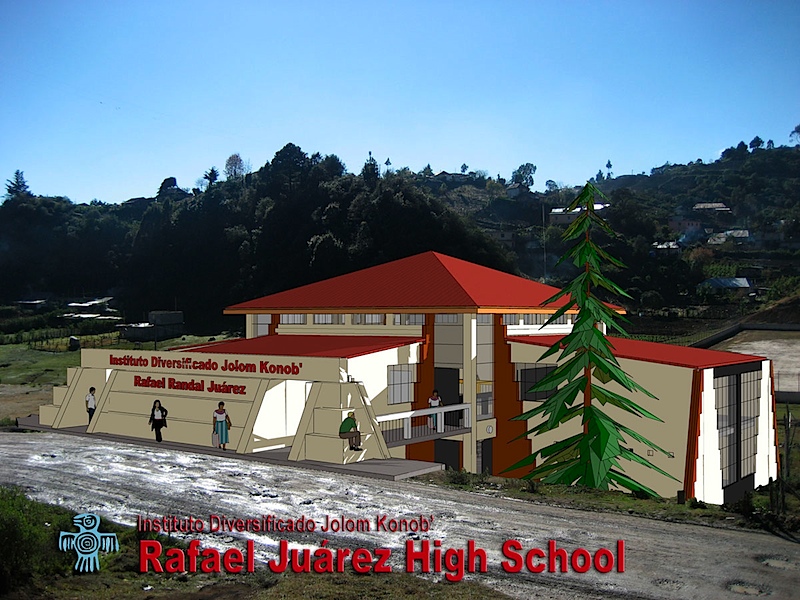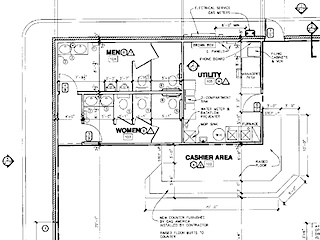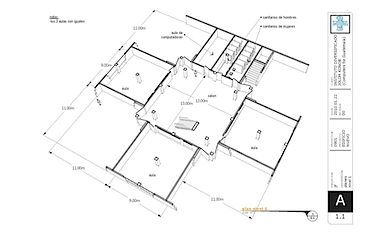The saga of the Rafael Juárez Instituto Diversificado Jolom Konob’ continues. As you may remember, I volunteered to be the architect on the new teacher’s institute in Santa Eulalia. I’ve not posted about it much lately, because frankly, an architect’s work is pretty boring to everyone except architects. Planning, drawing, setting up meetings, running calculations… whee! Honestly, it makes me miss my old job. But in the last few days, there have been some exciting developments.
The plans for the building are pretty close to done. However, I found out through the grapevine that the local builders don’t understand them. I guess this isn’t surprising; most people here are illiterate, and those that CAN read usually only made it to third grade. Even though there isn’t a lot of writing on a typical construction drawing, the way they’re presented is somewhat stylized and reflects centuries of standards and practice in the building industry. Therefore, I have had to re-invent the basic idea of what a set of building plans is. Here are two drawings to illustrate the point. On the left, a traditional drawing. On the right, the new style. You can click them to enlarge.
Having done that, I met with representatives of the comité de padres de familia (the equivalent of the PTA) and presented the drawings. Everyone seemed pretty excited about the school, saying that is was a beautiful place that they could all be proud of, and would be something unique in Santa Eulalia. The contractor Pascual continued to ask smart questions, and the director told me that they had settled on him to do the work. This is good news; the guy feels honest and has a vested interest in getting the job done fairly, as he’s also on the board of directors of the school. As we were making small talk, I mentioned that I was sad I missed the conquistador dancers this year at the town fair.
“You know, Pascual was one of the dancers this year,” the director said.
I mentioned a previous discussion with Aurelio about his grandfather, who re-introduced this traditional dance to Santa Eulalia several decades ago, and died just a few months back. “I know about that,” Pascual said. “He was my father.”
Are you kidding me!? Everyone is related to everyone here! But this is great news, it means that Pascual is Aurelio’s uncle, and a second-cousin to Don Ximon. And they are two of the most honest people I know in Guatemala.
The meeting continued, and eventually came around to why they’d called it. None of the local contractors had any idea how to do a real estimate of the building cost. I should have seen this coming. From early on, everyone had been asking me how much this would cost, and I told them the truth: I have no idea. I have never built in Guatemala before. “You need to get three contractors to give you estimates,” I said. “That’s how we do it. If the prices are all in the same range, that is probably what it will cost.” But I was still nervous; even though things are fabulously cheap in Guatemala, I have a tendency to overdesign stuff and always have to trim the budget. They question is usually, how much?
They did about half of what I asked; they got two prices, but who knows what the contractors were pricing. One estimate was Q460,000 and the other was Q368,000. And those prices are apparently just guesses. In the end, the committee somehow talked me into doing a material takeoff and price estimation for the entire 8,000 square foot building. Ugh. In the US, architects NEVER do this, partly out of liability concerns, partly because contractors are much better at it. And it’s a huge amount of work. But no one else even knew how to begin, and we really need the data, so that afternoon I made a spreadsheet and started adding it all up.
At about midnight, eyes bugging out from staring at the screen, I had a price for just the foundations: Q64,000. Uh-oh. Don had already told me that he was only going to donate Q232,000. I could see the train heading for the cliff, so I stopped and did a few rougher calculations to get the big picture. Then I sent the following sad email to Don, figuring the project had just died:
Hm
SO, i see that you mentioned a max price of 232,000q for the materials. I worked up a spreadsheet , put in all the parameters for the building, and ran some preliminary numbers for price. There is no way we are going to even come close to that cost unless we get some fantastic deals on materials. For my examples, I used local prices (I had to get three independent quotes on most of these materials last month, to do the USAID paperwork for my SPA project). The walls alone are going to cost us about 230K in materials:
|
|
Gasto
|
Gasto
|
rounded
|
|
|
|
TOTAL
|
Unidad
|
TOTAL
|
|
|
|
|
|
|
|
|
cemento
|
Q70,200.00
|
Q65.00
|
1080
|
saco
|
|
piedrin
|
Q8,610.00
|
Q210.00
|
41
|
camión
|
|
hierro 5/8”
|
Q66,375.00
|
Q295.00
|
225
|
quintal
|
|
hierro 1/2”
|
Q0.00
|
Q295.00
|
0
|
quintal
|
|
hierro 3/8”
|
Q20,650.00
|
Q295.00
|
70
|
quintal
|
|
hierro 1/4”
|
Q0.00
|
Q295.00
|
0
|
quintal
|
|
alambre de amarra
|
Q0.00
|
|
0
|
quintal
|
|
nylon
|
Q0.00
|
|
0
|
m2
|
|
bloc (20cm x 40cm x 15cm)
|
Q56,700.00
|
Q5.60
|
10125
|
c/u
|
|
sabieta
|
Q13,500.00
|
Q10.00
|
1350
|
saco
|
that is rough, and only a tiny part of the spreadsheet. But it gives an idea. I did a more detailed estimate on just the foundations, since they come first, and they are about 63K without the bodega (which I still don’t know if we need or not). I haven’t even looked into electrical, or plumbing fixtures, or plaster, or roofing, or terrazza, or anything like that.
This is interesting to me. The guy down the hill in Temux is building a house, and it is two rooms totalling about the size of a classroom. He once mentioned 40k as the price for a house. But houses around here have 2 bare lightbulbs for electricity, dirt floors, and everything on one level. If we were to use this as the benchmark, our building is 8 of these so would cost 320K. I wonder if Eulalia’s brother was planning on leaving the floors dirt?
I need to look into this more. I tried to imagine the cheapest way to get this school built: a collection of classroom boxes, spread out like a campus. Single-story tin roof, concrete floor, no windows, one lightbulb, one door. That comes to about 40k in materials per unit. 6 classrooms = 240K. That doesn’t include a restroom facility, kitchen, admin office, or hallways/ meeting space.
In pondering all of this, I find most of the earlier estimates to be VERY optimistic, even when envisioning an absolute bare-bones school. I tend to be a trusting guy, but I feel like them telling you those prices was either negligently misinformed, or intentionally deceptive to get you in past the point of no return. If your budget is what you say it is, I need to go back to the drawing board (so to speak) and we need to be thinking about the “campus of boxes” concept, and being frugal even with that.
I am beat, and going to bed. Think about this some and let me know what you want to do. Perhaps I too will have some better ideas in the morning.
And I went to bed, my head swimming with spreadsheets, masons, and Mayan teachers.
The next morning, I went about my regular business: meeting with villagers, transplanting seedlings, and talking with nurses. By the afternoon, I had some spare time, so I checked my email. There were several notes from Don, including this:
I think congratulations are in order. I heard, curiously not from Mario, that Mario is collecting Q1,200 from each family, to help pay for the materials. Those who can’t pay have to work weekends. I guess they like your design enough to sacrifice; a very good sign.
Eulalia spoke with Mario. The padres de familia had a meeting today and they raised Q6000. A fellow came from another town to enroll his child. When he saw your design he donated Q3000 on the spot. This afternoon I sent Mario your latest rendering with Rafael’s name on the front. The other padres saw the rendering and apparently were entralled, realizing their grandchildren would be using the school.
The funny thing about Guatemala is, if people really want something to happen, they tend to find a way. I was pretty amazed; the night before, it looked pretty hopeless. Now is seems that the people are behind the project enough that they are going to pass the hat. I have to hand it to Don; he’s done a pretty good job getting the locals involved emotionally and financially, a fundamental principal of good development work. But that’s not surprising, Don is a former PCV.
Eulalia (one of the major players in the project) told Don that she had a dream, in which Rafael Juárez appeared to her and told her that he would make sure the school got built. The Maya are a very spiritual people, and whether YOU believe it or not, something like that is very meaningful. After a Don, Eulalia, and I discussed it, the local Mayan priest was invited to bless the ground of the school. That is going to be Thursday, and I’ve been invited to attend. We’re not out of the woods yet, but things are looking up and I will keep you posted. For now, I have to get back to my spreadsheet.


